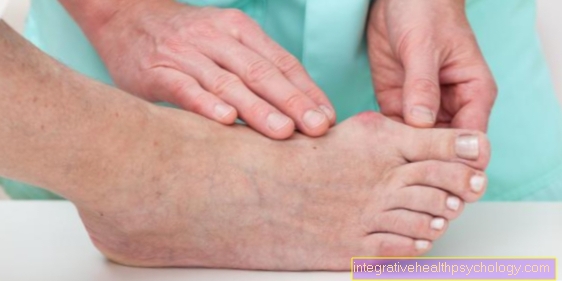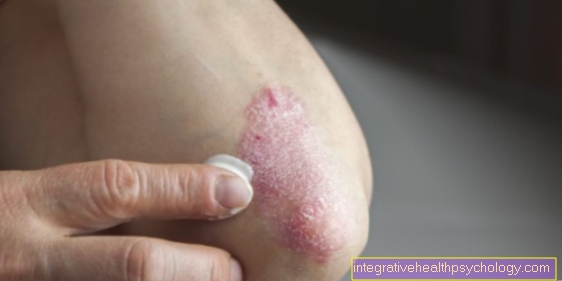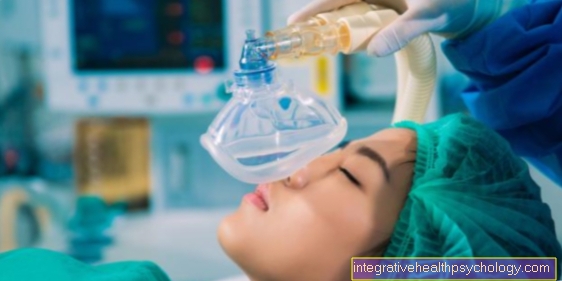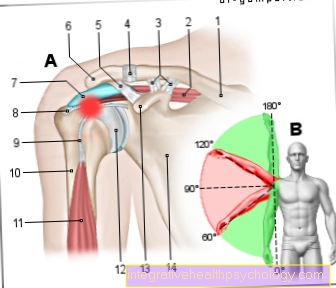Respiratory distress syndrome in the newborn
definition
Under the respiratory distress syndrome in newborns (also Infant Respiratory Distress Syndrome, or short IRDS) it is a shortness of breath that occurs acutely in newborns just a few hours after birth.
Premature babies are particularly often affected, as lung maturation is only completed after the 35th week of pregnancy. In the case of an impending premature birth, drug prophylaxis of an IRDS is therefore always attempted.
Statistically, at least 60% of children born before the 28th week of pregnancy develop respiratory distress syndrome. Mature children, i.e. children born after the 37th week of pregnancy, are only about 5% affected.

The cause of the respiratory distress syndrome in the newborn
The main cause of respiratory distress syndrome is insufficient production of a certain protein, the Surfactant. This protein is found on the surface of the alveoli of all people and ensures that these remain open and do not collapse.
The mechanism for this is the reduction in surface tension, which would otherwise be so great that the fine alveoli would not be able to withstand it. Surfactant is therefore the decisive factor for a good and undisturbed gas exchange in our lungs.
In newborns and especially in premature children, the surfactant is not yet formed in sufficient quantities, since the lungs are created early in the womb but only mature at the very end of pregnancy. Surfactant is normally only produced by the cells of the child's lungs from the 35th week of pregnancy.
In the case of respiratory distress syndrome, the alveoli partially collapse and the child has to exert itself disproportionately to get enough air.
Respiratory distress syndrome in newborns after caesarean section
After a caesarean section, the risk of the newborn child developing respiratory distress syndrome is generally higher.
It does not matter whether it is a premature or a full-term child. The explanation for this is that the stress at birth, especially the pressure contractions, cause an acceleration of the surfactant production via the release of certain hormones (glucocorticoids).
A deficiency in surfactant is the main reason for developing respiratory distress syndrome.
You might also be interested in: Diseases of a premature baby
Diagnosis of respiratory distress syndrome in newborns
The first clear indications of a respiratory distress syndrome in a newborn child are the symptoms typical of dyspnea and a relatively weak breathing noise when listening to the lungs.
In order to secure the suspected diagnosis, one uses the analysis of the oxygen or carbon dioxide content in the blood (blood gas analysis) and the representation of the lungs in the X-ray image.
The IRDS must be distinguished from other diseases that can also cause shortness of breath, such as underdevelopment of the lungs, pneumonia or amniotic fluid residues in the lungs.
Stages of respiratory distress syndrome in newborns
In order to objectify the severity of the respiratory distress syndrome, it has been divided into four stages.
Stage I describes the mildest clinical picture, stage IV the most serious.
No clinical symptoms are used for classification, as these vary individually in newborns. The stages are diagnosed exclusively according to the radiological findings of the X-ray image.
More precisely, it assesses how large the proportion of the alveoli that have already collapsed and are no longer available for gas exchange as a result. Since a higher stage means less lung tissue that can still be used, it also has a statistically worse prognosis.
X-ray image to diagnose respiratory distress syndrome in newborns
An X-ray is essential for confirming the diagnosis and for further grading the disease and should therefore be made if a respiratory distress syndrome is suspected.
Of course, radiation exposure should also be considered. However, this is now rather low with X-rays, so that the benefit of confirming the diagnosis and the then possible targeted treatment of the respiratory distress syndrome is usually greater.
The staging is based on the degree of "shadowing", that is, the proportion of the lung tissue that appears white in the X-ray image. The whiter the lungs appear in the image, the more impermeable the tissue was to the X-rays, as it already contains many collapsed alveoli that make the tissue denser. The highest (IV.) Stage of this disease is therefore sometimes also called the "white lung".
Accompanying symptoms of respiratory distress syndrome in children
In the case of respiratory distress syndrome, the symptoms characteristic of dyspnea are first noticed. These include, for example, nostrils, rapid breathing and bluish lips or mucous membranes.
Since the IRDS occurs more frequently in premature babies, further signs of immaturity can occur in the child, for example poorly developed subcutaneous fatty tissue, an inadequately developed immune system or lanugo hair, the so-called downy hair, which serves as temperature insulation before birth.
Therapy of respiratory distress syndrome in newborns
Ideally, the treatment of an IRDS begins in the womb: If there is a threat of premature birth, surfactant production must always be stimulated with medication.
This happens through the administration of glucocorticoids, i.e. molecules that are closely related to cortisone. These ensure that a sufficient amount of surfactant is produced within 48 hours.
This therapy is often combined with a contraceptive, provided that labor has already started. This saves enough time for the glucocorticoid to work.
If, on the other hand, a respiratory distress syndrome is found in a child who has already been born, certain immediate measures must be taken in the appropriate birthing center: Since the child's lungs are always in danger of collapsing, the pressure in the lungs must be maintained with the help of an official mask that sits firmly on the face. They should be supplied with enough, but not too much, oxygen, as this is harmful to newborns in high concentrations. In addition, one can consider whether supplying the missing surfactant is helpful in the individual case.
This is then brought in liquid form directly into the windpipe, from where it can spread through the bronchi into the alveoli.
You might also be interested in: Childbirth complications
How long does respiratory distress syndrome last in newborns?
How long the newborn has to cope with respiratory distress syndrome depends to a large extent on the stage of the disease.
If the respiratory distress syndrome is treated quickly and specifically at a lower stage, it usually only lasts a few days.
The limiting factor in the fastest possible healing of the syndrome is that the surfactant forms in the child's lungs as a result of the drug therapy or that the surfactant applied directly into the trachea is sufficiently distributed on the surface of the lungs.
If the disease is already in a higher stage, the duration is more difficult to predict. Especially in stage IV, lifelong consequences for the child cannot be ruled out.
Prognosis of Respiratory Distress Syndrome in Newborns
Whether and what consequences arise from a child's respiratory distress syndrome depends heavily on how quickly the treatment of the disease is initiated and what stage the disease is in.
If left untreated, this disease can be fatal, but with prompt and appropriate treatment, mortality is extremely low.
Complications and consequential damage rarely occur in a well-treated respiratory distress syndrome. Nevertheless, the possible consequences of a respiratory distress syndrome should be mentioned here: First of all, the lack of oxygen can affect the child's body. The brain has the lowest tolerance of all organs and is therefore damaged first. Due to the relative stiffness of the lungs, an entire lung can collapse (Pneumothorax). This can then be treated with the help of drainage.
In addition, ventilation with constant pressure and additional oxygen can create a so-called "ventilation lung". This is characterized by a combination of minimal pressure-related injuries, local inflammations, possibly pulmonary edema, localized overinflation and collapsed alveoli. This secondary disease can usually be treated with problems by adjusting the ventilation pressure and the oxygen content.
You can find another complication of premature birth at: Retinopathy of premature infants
Further information
- Premature birth
- Diseases of premature babies
- Retinopathy of premature infants
Further interesting information from the field of pregnancy:
- Termination of pregnancy
- Pregnancy depression
- Gestational diabetes
- Pregnancy complications
You can find an overview of all gynecological topics under: Gynecology A-Z





























